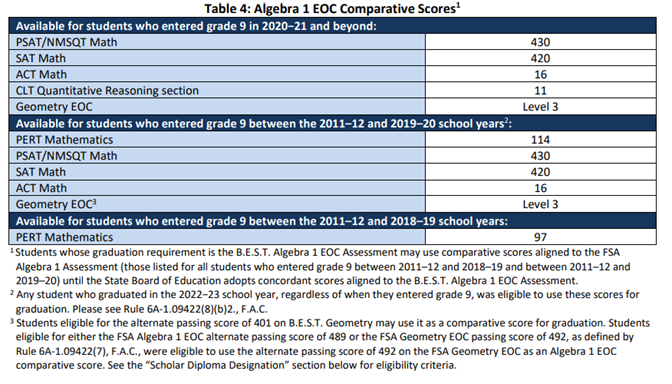Grade Forgiveness of a High School Credit by Middle School Students
Middle school students who have taken high school courses may receive grade forgiveness if they have earned a grade or the numerical equivalent of a C, D or F. In such cases, the district forgiveness policy must allow the replacement of the grade with a grade or the numerical equivalent of a C or higher, earned subsequently in the same or comparable course. For a grade of A or B, the course and grade cannot be forgiven; it will appear on the student’s high school transcript and will be used in the calculation of high school grade point average and for Bright Futures.
If a student fails the Algebra 1 EOC, the student may attend the summer algebra program and earn a .5 credit elective to prepare to re-take the Algebra 1 EOC (passing is a graduation requirement).
Grade Forgiveness for High School Students
State law requires a cumulative 2.0 GPA to graduate. Forgiveness policies for required courses shall be limited to replacing a grade of D or F, or their numerical equivalent, with a grade of C or higher, or its numerical equivalent, earned subsequently in the same or comparable course. Forgiveness policies for elective courses shall be limited to replacing a grade of D or F, or their equivalent, with a grade of C or higher, or its equivalent, earned subsequently in another course. These restrictions on forgiveness do not apply to students below grade 9 taking high school courses. Such students may repeat a course for forgiveness with grades C or below. If a student earns a grade of a D or F in a subsequent attempt of the course in which they have already earned credit, an additional grade from the subsequent attempt course will not be included in the student’s GPA. Once a C is earned through grade
forgiveness, all previous attempts are forgiven and are not included in the student’s GPA. Any course credit not replaced according to the district’s forgiveness policy shall be included in the calculation of the cumulative GPA required for graduation. All courses and grades must be included on the student’s transcript.
Schools may not count the best 24 credits for all courses taken to meet the cumulative GPA for graduation requirements. The district’s forgiveness policy is for the purpose of assisting students in meeting the requirement to attain a minimum grade point average necessary to graduate from high school or raise their GPA. Schools do not have the authority to purge a student record to delete the first grade of D or F. Student records cannot be altered at any time unless it has been determined that the information is inaccurate or a violation of the privacy or other rights of the student.
Credit Recovery Courses
The State Board of Education approved 23 high school credit recovery courses in July 2012. Some of these courses have state EOCs and others do not. Credit Recovery Courses may be used for Grade Forgiveness / Credit Recovery as well as remediation, and they may be taken in a traditional classroom, a credit recovery lab or through virtual school. Courses offered through a private school may not be used for credit recovery without prior approval by Secondary Instructional Services.
Credit Recovery Courses are .5 elective credit semester courses with specific content requirements defined by the Florida Standards and a maximum of one credit per course. Students enrolled in a Credit Recovery Course must have previously attempted the corresponding course and end-of-course (EOC) assessment, since the course requirements for the Credit Recovery course are exactly the same as the previously attempted corresponding course. For example, Geometry (1206310) and Geometry for Credit Recovery (1206315) have identical content requirements. However, Credit Recovery courses are not bound by section 1003.436(1)(a), F.S., which requires a minimum of 135 hours of instruction. Students who are college-bound athletes and are registering with the NCAA Clearinghouse cannot do credit recovery (APEX/Edmentum), per NCAA Guidelines. To recover failed courses, college-bound athletes may only do grade recovery through brick-and-mortar classes, FLVS, or SJVS courses.
Grade Forgiveness and EOC Retake Policy
A high school student who is retaking an EOC course for grade forgiveness and has already taken the EOC is encouraged to retake the EOC but is not required. If the student does not retake the EOC, then the previous EOC results must be averaged into the grade for course average. Grade forgiveness does not mean a new grade without the EOC averaged in.
If the student’s final average with the EOC assessment included as 30 percent results in a course grade of “D” or “F”, the options for the student include one of the following:
- Retaking a semester of the course
- Retaking the entire course
- Retaking the EOC assessment for that course; and
- Retaking both the course and the EOC assessment to improve the student’s final course grade.
A student may retake an EOC to qualify for the scholar designation or as part of a grade forgiveness program.
Grade Challenge Procedures
Grading is primarily the responsibility of a teacher as long as the grade is determined in a manner that is consistent with state and district policies. Any concern a student/parent/legal guardian has with a final grade should be brought to the immediate attention of the teacher of record who awarded the grade. A final grade is defined as a grade documented at the end of a grading period and/or an end of the course cumulative grade.
If the teacher of record is unavailable, or if the student/parent/legal guardian wish to appeal the teacher’s decision, they must supply a written summary of the concern including any evidence that would serve as justification for the appeal, to the school principal for consideration and a final decision.
In the event that the school principal is unavailable, the appeal would go to the appropriate District Director of Curriculum for consideration and final decision.
All grade challenges must be completed during the school year in which the grade was awarded, and no later than the start of the next school year. Exceptions to this timeline would only be granted by the principal.
Concordant and Comparative Scores
A student can also meet assessment graduation requirements by earning a concordant or comparative score as specified in Rule 6A-1.09422, F.A.C. Tables 3 and 4 show the concordant and comparative scores students may use to satisfy assessment graduation requirements.


Students holding a Certificate of Completion must meet concordant score requirements based on the test taken, since changes were made to the SAT content. As always, students may use a combination of SAT and ACT scores to meet the high school graduation testing requirements.


